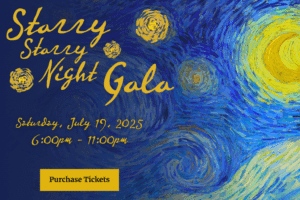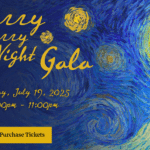Original Article:
American Visions of Liberty & Freedom – The Journal of Antiques and Collectibles – June 2006
Updated June 2025:
Starry Starry Night Gala 2025: A Celestial Celebration at Heritage Museums & Gardens
On the evening of July 19, 2025, Heritage Museums & Gardens in Sandwich, Massachusetts, will host its annual gala, themed “Starry Starry Night.” Inspired by Vincent van Gogh’s iconic painting, the event promises an enchanting experience under the stars.
Event Highlights
-
Date & Time: Saturday, July 19, 2025, from 6:00 PM to 11:00 PM
-
Theme: “Shimmer, Shine & Gogh All Out!”
-
Activities: Guests will enjoy cosmic cocktails, celestial-themed cuisine, and dancing beneath the stars in the beautifully illuminated gardens.
-
Attire: Attendees are encouraged to dress in outfits inspired by the night sky or impressionist art, embracing hues of celestial blue and golden stars.
Supporting Heritage’s Mission
All proceeds from the gala support Heritage Museums & Gardens’ year-round operations, including the maintenance of its gardens, exhibitions, and educational programs. By attending, guests contribute to preserving and enhancing this cultural landmark.
Experience the Magic
Set against the backdrop of Heritage’s lush gardens and under the canopy of a starlit sky, the “Starry Starry Night” gala offers an unforgettable evening of art, nature, and community. Whether you’re a longtime supporter or a first-time visitor, this event is an opportunity to celebrate and support the vibrant offerings of Heritage Museums & Gardens.
Original Article:
American Visions of Liberty & Freedom – The Journal of Antiques and Collectibles – June 2006
On View at the National Heritage Museum – Lexington, Massachusetts
What do palmetto trees, rattlesnakes, and the Statue of Liberty have in common? The answer is revealed with a visit to “American Visions of Liberty & Freedom” on view at the National Heritage Museum, July 1 through October 15, 2006. The exhibition shows how generations of Americans from Revolutionary times to the present, have drawn, carved, and quilted symbols to represent their sometimes-conflicting definitions of liberty and freedom. Among the more than 200 objects in the exhibition are icons such as the Statue of Liberty, Uncle Sam, and the American flag that have been revived, revised, reviled, or reinterpreted to express the concerns of succeeding generations.
For example, following the September 11, 2001, attacks, all U.S. Navy vessels were ordered to fly the navy’s original red-and-white striped naval jack bearing a rattlesnake and the words “Don’t Tread On Me.” This was the jack used in the Revolutionary War, and its use was revived as a symbol of our nation’s traditional resolve. The flag on view in the exhibition was flown aboard the USS Nashville during Operation Iraqi Freedom. Similarly, the palmetto tree, a Revolutionary War symbol of South Carolina’s resistance to the British, reappeared during the secession movement of 1860-1861.
The first exhibition section, “E Pluribus Unum,” deals with the mounting protest against British policies such as the Stamp Act, Townshend Acts, and Tea Act. Regional symbols of resistance, like the backwoods rattlesnake symbol, spread throughout the nation. After the war, the new nation realized it needed unifying symbols for the nation’s varying interpretations of liberty and freedom. Important objects in this section are a Liberty Tree powder horn, a 1790 cotton textile panel called “The Apotheosis of Franklin,” and a rare silver badge from the African American “Bucks of America,” a Massachusetts Revolutionary War unit composed of former slaves.
“A New Birth of Freedom” deals with the place of African Americans in American society, terminating in civil war. The abolitionist movement, secession movement, Confederacy, and Union each had its own symbols. The hammer of an 1863 rifle is cast in the shape of President Abraham Lincoln’s head, and a whale’s tooth is incised with a picture of a member of the United States Colored Troops. An African American in his country’s uniform, bearing a weapon, was a powerful symbol of freedom, especially to black Americans.
“The Golden Door” focuses on issues of economic justice from the unveiling of the Statue of Liberty in 1886 through the New Deal to the globalization issues of today. Section Four, “Freedom Now!” shows the symbols invented by 20th-century social movements including the woman suffrage and civil rights movements, and how liberty and freedom are invoked by both sides on some of today’s issues. The final section, “To Make the World Safe for Democracy,” examines the tension between liberty and security in wartime, from the Spanish American War to the war against terrorism.
The exhibition is funded by the National Endowment for the Humanities and organized by the Virginia Historical Society with additional support from the E. Rhodes and Leona B. Carpenter Foundation and the Lettie Pate Whitehead Evans Changing Exhibitions Fund.
The National Heritage Museum is dedicated to presenting exhibitions and public programs on a wide variety of topics in American history and popular culture. The Museum is supported by the Scottish Rite Freemasons in the Northern Masonic Jurisdiction of the United States. The Museum of Our National Heritage is located at 33 Marrett Road in Lexington, at the corner of Route 2A and Massachusetts Avenue. Hours are Monday through Saturday from 10 am-5 pm, and Sunday, noon-5 pm. Admission and parking are free. Heritage Shop and Courtyard Cafe on site. For further information contact the Museum at (781) 861-6559. For more information, visit our web site at www.monh.org.







Related posts: